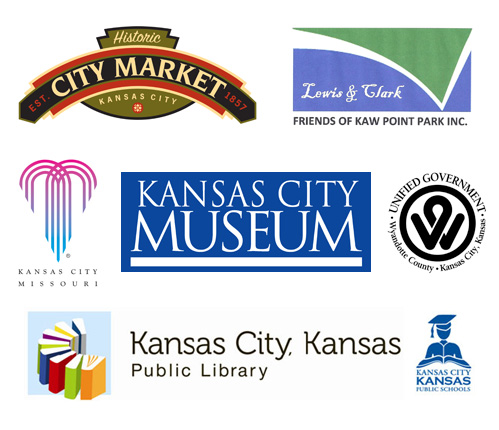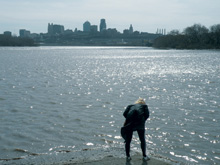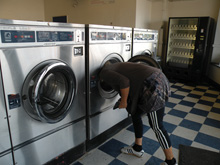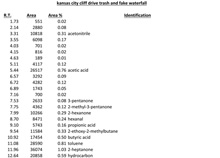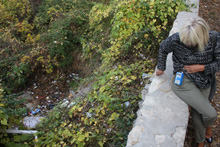What happens next, and later, in the expansive olfactory process – what happens physiologically, psychologically, socially and culturally – is the basis of inquiry that motivates Sissel Tolaas’ work. She constructs synthetic systems of provocative smells in order to explore questions of perception, communication and context. In 2007, at Grand Arts, she exhibited swaths of pale paint mixed with synthetic sweat, reproduced from the sweat of nine men who suffered from panic attacks. She fills crystal bottles with odors reproduced from the smells of homeless camps. She makes fancy cheese from human bacteria Tolaas repackages the medium so that we might reconsider the message – ideally, with more tolerance this time. We’ve become hypersensitive to hygiene rather than to the rough knowledge our collective senses offer (and to be unclean is to be lower class, third world, poor). For perception we rely primarily on sight, which necessarily requires distance. Gleaming glass buildings in our cities, granite kitchen countertops in our homes: These sleek surfaces imply impenetrability, polish, control. Like the American motel bathroom, the Western world has been sanitized for your protection – the equivalent of sensuous death, according to Tolaas. There are no hiding places; therefore, there is no danger. What you see is what you get. Smell undermines this perception. The olfactory is paradoxical, both our fastest and slowest sense: It depends on fickle messages delivered on fickle winds, yet the brain interprets those messages faster than it does with any other sense. Unlike colors or chords, smells cannot be predictably combined. They cannot be easily measured; odor has no wavelength. They cannot even be captured, if the molecules dissipate first. Smells permeate and immerse – even when we sleep, we smell – but are fleeting, impermanent and ephemeral in their natural states. If the distance required for eyes to correctly function connotes rationality, the indefinite fumes and plumes of smell seem mad by comparison. So: What if we considered smell on its own terms instead? In the 16th century, Michel de Montaigne published a brief essay in which he noted the odor-preserving capabilities of his mustache. “If I bring my gloves or my handkerchief near it,” he wrote, “the smell will stay there a whole day. It betrays the place I come from. The close kisses of youth, savory, greedy, and sticky, once used to adhere to it and stay there for several hours after.” As an image, Montaigne’s mustache is a useful one. It amuses. It delights. It arouses knowledge we already have: As smell sticks to mustache, memory sticks to smell. Hours after a goodbye kiss – hours after, and you’re still in its grip – a trace floats up, unloosed from shirt or skin, and the essence of the other, of the morning or afternoon or night, takes fierce hold in the here and now. How unbearable this effect when said kiss was last in a line: You drag a hand across swollen eyes – as not to fall off the sidewalk, as not to be hit by a bus – and the cruel molecules ascend to evict you from the present and future. You know the trip. The transportive nature of smell betrays us all. You couldn’t avoid it if you tried. The olfactory cortex is embedded in the limbic system and the amygdala and hippocampus, where the brain stores emotions and memories (and memories of emotions). Olfaction influences hormone production, too, via the pituitary gland, and as such affects general bodily function. The molecules tangle: scent and longing, mind and body, once before and now again. The information is impossible to separate. The limbic system is one of our older brain structures, and olfaction, a primitive sense. It evolved to evoke strong emotions – the tool by which our ancestors chose to fight or flee, the key by which newborns first recognize their mothers. In contrast, olfaction has relatively few direct connections with the youngest part of the brain, the left neocortex, where language is processed. (Consider as evidence the fact that we can distinguish among thousands of odors but lack smellspecific description, instead relying on taste-associated terms or reference to the smell source itself to narrate our olfactory experience.) Smell ceded cognitive primacy to sight following the scientific revolution, possibly in part because smell’s emotional potency precluded it from the detached impersonality of modern scientific thinking. But increasing contemporary research points to cognitive factors in olfactory play.
Data suggest that odor perception is equally complicated. When a smell wafts into the nose, we perceive the character of the odor in terms of intensity, quality and hedonics. Part of that perception is a function of chemistry. (It starts with a molecule.) Part is a function of our individual selves. This is what Tolaas’ SmellScape KCK/KCMO project illustrates: Memory and emotions sway perception, but context, education and experience bear weight, too. To begin, Tolaas collected smells from six areas of Kansas City, Mo., and Kansas City, Kan. – neighborhoods with deep histories, broad ethnic traditions and intense smells. She mapped and synthetically reproduced location-specific odors, abstracting them in the form of scratch-and-sniff Smell Cards. The project depends on participants walking unfamiliar streets, cultivating mindfulness of smell as an important sensory act. If the streets are already familiar, participants are asked to experience them through an unfamiliar tool: the nose. Smell permits a rediscovery of environment, Tolaas says, whether that environment is social, cultural, geographical or otherwise. In her project statement, she describes the playfulness that emerges when people engage with her work: Regardless of whether they find a smell pleasant or unpleasant, they are made suddenly aware of this other, this more. They perceive their surroundings differently than they had before. The mood is changed. The mood is improved. Montaigne noted this of odors, too: “I have often noticed,” he wrote, “that they make a change in me, and work upon my spirits.” A more comfortable relationship with smell encourages optimism; optimism is crucial in remediating the current ecology of the senses. This logical progression begets the ultimate form of SmellScape KCK/ KCMO: A game. Though Tolaas has completed similar smell-mapping projects in Paris, Berlin, Mexico City and elsewhere, Kansas City is the first in which she so plainly incorporates discovery and fun in the design. Participants are challenged to explore six neighborhoods on foot – the medium of the gallery repackaged as the city – as a means to find and collect the odor-abstracted Smell Cards (which players describe for additional points). A live map, viewable online and in the gallery, displays words and images signifying participants’ experiences. Grand Arts commissioned a custom SmellScape KCK/KCMO mobile app, too, underscoring both the novelty and seriousness of adopting a new approach to our oldest sense. Chemical communication – the means by which Earth’s earliest bacteria fed and reproduced – has more influence on us than we realize. Earlier this year, researchers confirmed that humans can identify the ages of other humans based on differences in body odor. A 2011 study demonstrated that men who sniffed “unhappy” female tears experienced decreased levels of sexual arousal and testosterone without ever witnessing the act of crying. Another revealed that, left unchallenged, one’s sense of smell withers. Education can revive the olfactory capacities, Tolaas says. We recall images with almost 100 percent accuracy within minutes of a visual-recognition test, but precision falls rapidly with time; in comparison, we distinguish among smells with about 20 percent accuracy and a year later remember them almost exactly. More new research indicates that prolonged sensory exposure to a single odor – about three and a half minutes – immediately enhances the ability to discriminate among odors in a similar family. Our sense of smell is both powerful and apt. Olfaction could provide new ways to interpret environments, facilitate more sensitive communication, and increase tolerance of other people and cultures. (Maybe if we trained our olfactory systems by smelling “negative” odors removed from the context of their sources, the sources would seem less “negative” the next time we smelled them.) It could inspire fresh modes of perception, imagination, navigation, education and beyond. Consider smell as aesthetic experience. Smell as invisible architecture and design. Smell as materiality – as a meaning-making vehicle of its own. To be more conscious of these possibilities, the first step is a better understanding of reality. To that end, SmellScape KCK/KCMO encourages thought. It starts with a molecule. Where it goes next is up in the air.
THANK YOU TO OUR SMELLSCAPE COLLABORATORS REVIEWS
|

